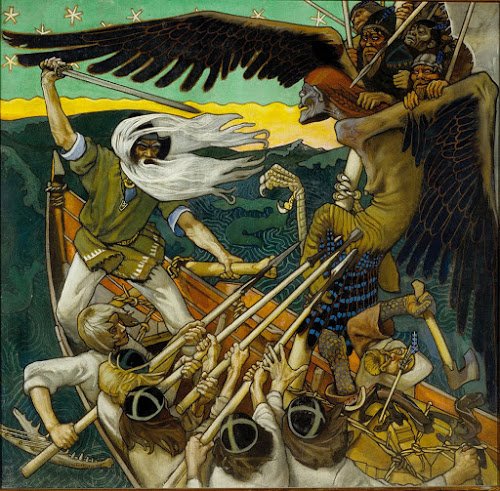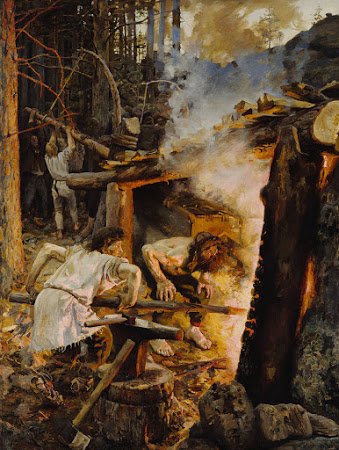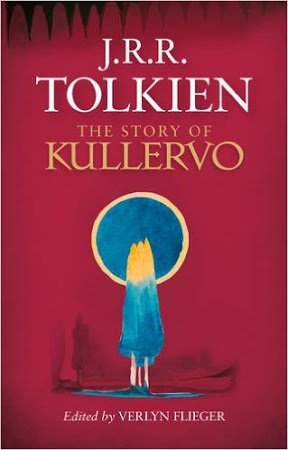Kalevala: An epic folklore of Finns - A source of inspiration for Tolkien's mythology
Kalevala is a Finland's and Karelia republic's national epic, a collection of folklore poetry gathered and put together by Elias Lönnrot, a physician and a language researcher who was an important character in the development of Finnish language.

Source
Akseli Gallen-Kallela: Sammon puolustus,"Defending of the Sampo" (1896)
Väinämöinen with his men defending the Sampo from Louhi, who has turned herself into an eagle
What is it about?
Kalevala is a myth about the creation of the world and it tells about the struggles of the nations (and their people) of Kalevala (hence the name of the work; it's the location where most of the events are set upon being the homeland of its heroes) and Pohjola, "the North", which is considered as evil and the enemy of Kalevala people.
The fight for Sampo, a powerful artifact, is a common theme in Kalevala and many characters are struggling to get their hands on it.
Finnic map
World map
Finnic nations around the Baltic Sea that used the Kalevala meter.
The Kalevala meter
The newest Kalevala (1849) contains 50 poems and 22 795 lines which follow the Kalevala meter (almost identical to trochaic tetrameter) of eight syllables per line, the emphasis being on every other syllable starting from the first. The meter was used in all Baltic-Finnic language poetry and it worked as a framework allowing the tradition of folklore to be remembered and passed on by singing.
Important characters
Väinämöinen -- The main hero, a wise old wizard who has a gift of magical singing and playing, kantele as his instrument of choice, made by a pike's jawbone. He has been around since the beginning of the world and one of his quests is to find a wife for himself.

Source
Shirtless Ilmarinen in the painting of "The forging of the Sampo" (1893) by Akseli Gallen-Kallela
Seppo Ilmarinen -- A heroic blacksmith, "forger eternal". Took a part in creating the sky and later forged the Sampo. Outside of Kalevala known as a god (Ilmarinen, aka. Ilma which directly translates as air) of wind, weather and air, who had been worshiped by Finnics.
Sampo -- Not a character but a central part of the plot, a magical artifact forged by Ilmarinen providing wealth and fortune to its owner.
Louhi, Mistress of the North -- Shamanistic matriarch of Pohjola, a sparse teethed and strong nosed witch who has tremendous magical abilities and beautiful daughters that men aspire.
Joukahainen -- A young challenger of Väinämöinen.
Kullervo -- Beautiful and yellow haired man, an orphan who was maltreated as a child.
Lemminkäinen -- A strong but shameless red haired hero who is tempted to war and women.
Cultural Influence
Kalevala has had a major impact on enhancing identity and creating a national sentiment for Finnish people; many artists, like composer Jean Sibelius and painter Akseli Gallen-Kallela, have pulled inspiration from its occurring themes. Everywhere you go in Finland, cities are full of names from it (I happen to live in a district named Kaleva and right next to me is a Kindergarten of Ilmarinen).

Source
Although written over hundred years ago, "The Story of Kullervo" got published just in 2015.
Outside of Finland the most known influence has been on J.R.R Tolkien, the author of the "Lord of the Rings".
While studying languages in Oxford in 1910's, young Tolkien came across English translation of Kalevala. After reading it he made his own interpretation of Kullervo's story. Although never finishing it throughoutly, it gave him confidence in his abilities as a prose writer.
Besides the story of Kullervo, Tolkien's work has common themes with Kalevala in Silmarillion which is a mythological history work considering the creation and early events of the world of Hobbits [Arda as Tolkien named it, which also includes Middle-Earth].
The Finnish language itself was also adored by him; beeing a language lover, he wanted to read Kalevala by its original language too. While learning Finnish grammar he described it being like: "entering a complete wine-cellar filled with bottles of an amazing wine of a kind and flavour never tasted before". Inspired by it he started working on his first fictional language: quenya which was to be the language of the ancient elves in Tolkien's universe.
Here is a funny cross over video, "The Lords of the Sampo", about the same topic
Characters like Väinämöinen and Louhi have been featured in Don Rosa's Donald Duck tale, "The quest for Sampo", dedicated to his Finnish fans where Uncle Scrooge tries to get his hands on the mythical wealth generating artifact of Sampo.

Source
Iku-Turso terrorizing Helsinki on top of the "Tuomiokirkko" cathedral.
My becoming Kalevala-series
Finally I'm going to read Kalevala by myself naturally with its original language as I'm a Finn and I got an idea that I could make a synopsis or a kind of a short story from every poem in a easy digestible form that I could share here (I don't expect everyone to read the whole thing, though I recommend it if you are interested: it has been translated to many languages). Telling the story would also give me some rehearsal helping me internalize it better.
What do you think of my idea? Let me know if you would be interested on reading it.
You did an excellent job about Vainamoinen. It is always a great experience reading about other cultures and their stories. Thank-you @celestal!
Thank you @cabbagepatch, stories and mythologies are great! Most of Väinämöinen's adventures are still ahead ;)